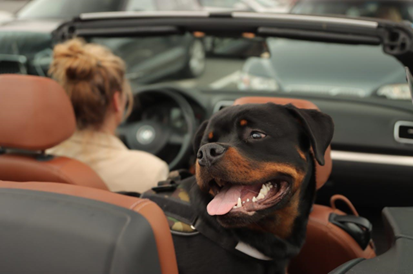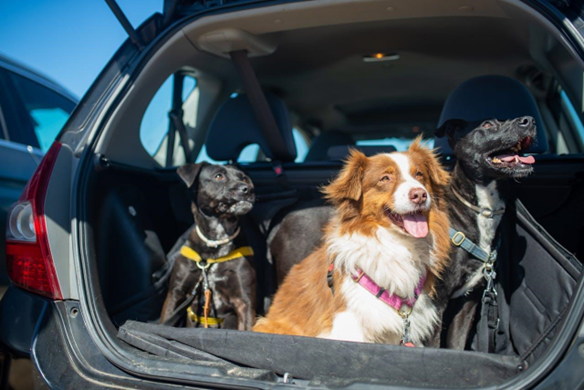Deciding to travel with pets requires careful planning and preparation. It’s also essential to ensure their safety and comfort. Whether taking a short trip or relocating, understanding your pet’s needs can make the experience more enjoyable for both of you. Of course, there are essential tips for traveling with your non-human companions. Every animal is unique and may have different needs while traveling. Take the time to understand these needs, thus making the trip more enjoyable for everyone involved.
Choosing the Right Mode of Transport
Don’t skimp on picking the right mode of transport for your pet. Each method has its benefits and drawbacks. Consider your companion’s size, breed, and temperament to select the best option.
Car Rental
- Pros: You can control the environment, take breaks, and ensure your pet’s comfort. Pets are usually less stressed in familiar surroundings.
- Cons: Long drives can be tiring. Frequent stops are necessary for exercise and bathroom breaks. Pets may experience motion sickness.
- Tips: Use a pet carrier or seat belt harness for safety. Pack essentials like food, water, and waste bags.
Air Travel
- Pros: Fast travel, especially for long distances. Some airlines offer specific services for pets.
- Cons: It can be stressful for pets due to noise, pressure changes, and unfamiliar environments, especially on long-haul flights. Not all airlines are pet-friendly.
- Tips: Check airline policies in advance. Use a well-ventilated, airline-approved carrier. Acclimate your pet to the carrier before the flight.
Train Travel
- Pros: Trains have more space than cars or planes, so pets can move around more freely. Some trains are very pet-friendly.
- Cons: Limited routes and schedules. Not all train companies allow pets. Noise and movement may stress some pets.
- Tips: Reserve a pet-friendly cabin. Bring a comfortable carrier and your pet’s favorite items to reduce anxiety.
Bus Travel
- Pros: Economical option for short trips. Some bus companies allow small pets.
- Cons: Space is limited, and not all bus companies permit pets. On top of that, longer trips can be stressful due to frequent stops and crowding.
- Tips: Confirm pet policies beforehand. Use a secure carrier and bring essential supplies.
Choosing the right transport mode can make a true difference. Consider all options and your pet’s needs to ensure a smooth trip.

Essential Preparations Before the Journey
Preparing for a trip with your animal involves several key steps. First, visit the veterinarian for a check-up. This ensures your pet is healthy and up-to-date on vaccinations. Your vet can also provide a health certificate often required for international travel. Next, gather all necessary travel documents. Depending on your destination, this may include a pet passport, health certificates, and vaccination records. Additionally, packing a travel kit for your companion is essential, with food and water for the trip and bowls for feeding. Bring a leash, waste bags, and any medications your pet needs.
In many ways, relocating with a pet is similar to traveling with them. Because of this, there are many resources and stories people share online about the whole experience. Furthermore, many moving companies like Lippincott Van Lines have customers who regularly have to move with pets. Their expertise and tips can also prove invaluable if you’re struggling to focus on what you should prioritize before the trip. So, if you are preparing to travel with pets for the first time, don’t hesitate to do thorough research. The more informed you are, the more likely the whole trip will be an enjoyable experience.
Safety Measures During Travel
For starters, use a sturdy carrier or a pet seat belt harness in the car. This prevents moving around and keeps them safe in case of sudden stops. Following that, try to keep the vehicle’s temperature moderate. Avoid leaving your pet in a car unattended, especially in hot or cold weather, to prevent heatstroke or hypothermia. Especially on long car trips, take breaks every few hours for your pet to stretch and hydrate.
In addition, ensure your pet wears an ID tag with your contact information. Microchipping provides an additional layer of security in case your pet gets lost. Feed them a few hours before traveling to minimize motion sickness. Don’t forget to offer water regularly to keep your pet hydrated. As an added precaution, bring along your pet’s favorite blanket or toy. Familiar items can help reduce stress and make your animal feel more at ease during the trip. Proper planning and attention to their needs make travel with pets easier and more enjoyable.

Accommodation and Pet-Friendly Destinations
Sometimes, your furry companion is the perfect travel mate, so finding the right place to stay is essential. Many hotels, motels, and vacation rentals now offer pet-friendly options. Before booking, verify the pet policies, including size restrictions, fees, and available amenities. Look for accommodations that provide pet beds, bowls, and designated walking areas. These extras can make your stay more convenient. Websites like BringFido and PetsWelcome can help you find suitable places.
While planning your trip, explore destinations with pet-friendly activities. Many cities offer parks, beaches, and hiking trails where pets are welcome. Check local regulations and leash laws to ensure a hassle-free experience. Choosing pet-friendly accommodations and destinations allows you to enjoy your trip without worrying about your pet’s comfort and safety.

Handling Anxiety and Common Challenges when You Travel with Pets
Traveling with pets can be stressful, but understanding their needs can help reduce anxiety and address common challenges. They may show signs of stress, such as panting, whining, or restlessness. Recognizing these signs early enables you to take action. To ease anxiety, bring familiar items like their favorite toy or blanket. Also, create a calm environment by speaking softly and maintaining a relaxed demeanor. If your pet has severe anxiety, consult a vet about possible medications.
Common travel challenges include escapes, health issues, and accidents. To prevent these, ensure your pet wears a collar with identification tags and is microchipped. Keep emergency contact numbers for local vets handy. Finally, accidents can happen, so prepare by bringing cleaning supplies and waste bags. If your pet gets carsick, avoid feeding it right before the trip and consult your vet about motion sickness remedies.
Wrap-up
As you can see, careful planning and understanding of their needs are required when you want to travel with pets. Proper preparation ensures your animal’s comfort and safety. Choosing the right transport, preparing essential items, and finding pet-friendly accommodations are vital steps. Addressing travel anxiety and common challenges helps make the trip smoother. Overall, prioritizing your pet’s well-being creates a more enjoyable experience for both of you.


I have not traveled with pets yet. In fact, I don’t behave any pets. However, thank you for sharing this information. Good post.
I don’t have any pets, but I would love one. I’m thinking about getting a dog a]because of how friendly loving they can be. Having a pet is a lot of responsibility though, as can be seen from this post. They’re like taking care of a child. I want a perm but I’m not sure if I’m up for the challenge. Having a furry companion would be really nice though! Thanks for sharing this post!